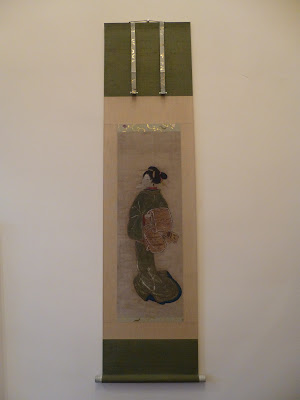Photo upload done twice as blog shows them up last first, but when I try the other way round it does the opposite - trials!
In talking about craft and the work done by hand, I am reminded of William Morris's book 'The Story of the unknown Church'. All those crafts people over the centuries building and adorning our churches with carving and stone work all forgotten now. We exclaim with wonder at their skills but do not know their names.
--------------
Some things you approach with a sad heart and the knowledge that happiness will never be experienced as it was then. But time takes the edge of the pain and you face up to what life brings you.
So I will show a shortened sequence of photos of how a Japanese scroll is restored. It is fairly dull repetitious work but it requires great skill and patience, as Pat underlined yesterday.
The scroll was done for an old client of Paul's but I haven't shown M because privacy is something to be honoured, although he helped in places. It is the client who chooses the various materials that are used in the restoration.
Something that is perhaps not understood about Japanese culture, is not only the great show of politeness but also the strong religious and cultural ties to the old ways. A scroll would not necessarily be left on the wall in a permanent state, but seasonal subjects would be hung, often in the tea house, where the rigid formality of taking tea would be undertaken.
The subject of the scroll is called 'Bjinga with Tissue', and it is probably of a lady of the night, so often wooed in the already mentioned tea-house.
Paul was enormously tidy, some, like me, would say excessively tidy, but that was his job. "Do not walk about eating biscuits sweetheart" he would say and one reason why we never had any animals at Chelmsford, hairs in the studio was a no-no.
 |
| Original state |
 |
| old tissues removed |














I think this illustrates well why I can't stand tv programmes like Sewing Bee and Pottery Throwdown, which involve making things within a time limit, with tension ramped up by the presenters. In my book, you take the time to get things right first time. It's not a race against the clock.
ReplyDeletePaul did 10 years apprenticeship, at the Japanese studio, the time it takes for 'aged' paste to mature. It is made in a big pot, and is stirred once a year. As you say the programmes you mentioned are not into slow time Tasker.
ReplyDeleteGosh, what an amazing talent your Paul had! Like you mentioned, the years of training and the slow process involved in the restoration really takes a lot of dedication. It's beautiful work, Thelma! Thanks for sharing these photos.
ReplyDeleteI must have taken a whole raft of photos to show the work needed to restore. I suppose it is very like the 'Repair Shop' idea Ellen.
DeletePaul was clearly a dedicated, skilled artisan...such beautiful, meticulous work.
ReplyDeleteHe had grown to dislike it towards the end Mary, knees and eyes had started to feel the strain.
Delete